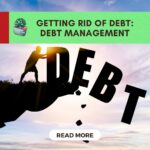Debt can be a heavy burden, weighing down individuals and families alike. Whether it’s credit card debt, student loans, or medical bills, the financial stress can be overwhelming. But fear not, for there is a path to financial freedom. This comprehensive guide will equip you with the knowledge and tools to getting rid of debt and achieve financial stability.
We’ll delve into practical strategies for creating a budget, prioritizing debt repayment, and increasing your income. You’ll learn how to make informed decisions about debt consolidation, debt settlement, and credit counseling. Additionally, we’ll explore the emotional impact of debt and provide tips for managing stress and maintaining a positive mindset.
By the end of this guide, you’ll have a clear roadmap to a debt-free future. Let’s embark on this journey together and reclaim your financial power by getting rid of debt.
Understanding Your Debt
Gaining a clear understanding of your debt is the first step to being able to get out of debt. By analyzing your obligations, you can create an effective plan to manage and eliminate them.
Assess Your Financial Situation:
Start by calculating your total debt, including all outstanding balances and their corresponding interest rates. Identify high-interest debts, as they typically cost the most over time. Reviewing your credit report and credit score is also essential to understand how debt affects your financial health and to spot potential errors.
Too much debt can be emotionally overwhelming, so adopt strategies to manage stress, such as breaking goals into smaller milestones, seeking support from loved ones, or practicing mindfulness to maintain focus and positivity throughout the repayment process.
Prioritize Your Debts:
Two popular strategies for debt repayment are the debt snowball and debt avalanche methods. The debt snowball focuses on paying off smaller debts first, providing psychological momentum as each balance is cleared. Conversely, the debt avalanche targets debts with the high interest debt first, saving money in the long run. While the debt avalanche is mathematically efficient, the debt snowball can be more motivating for some individuals.
Choose a method based on your personality and financial goals—those who need quick wins may prefer the snowball, while others focused on minimizing interest may benefit from the avalanche. Tailor your approach to fit your circumstances and adjust as needed to stay on track on all your debt.
Creating a Budget
Use budgeting tools and apps like Mint, YNAB, or Excel templates to track your net income and spending effortlessly. Categorize expenses into essentials (e.g., rent, utilities) and non-essentials (e.g., dining out, subscriptions) to identify areas where you can save. Look for patterns and prioritize cutting unnecessary costs to free up money for your financial goals.
Not sure which method is right for you? Take our free quiz to find out!
Prioritize Debt Repayment:
Commit a significant portion of your income toward reducing debt, focusing on high-interest balances first. Simultaneously, aim to build an emergency fund with at least three to six months of living expenses to avoid relying on credit for unexpected costs. Balancing these priorities ensures you can manage emergencies without derailing your debt repayment plan.
Budgeting Tips
Save money by adopting simple strategies like meal planning to reduce dining out costs, tackling DIY projects instead of hiring professionals, and canceling unused subscriptions. Small changes can add up quickly, helping you free up cash for getting rid of debt or other financial goals.
Increasing Your Income
Boosting your income is a key strategy for achieving financial stability and getting rid of debt. Whether through side hustles, salary negotiations, or selling unwanted items, exploring additional income streams can help you reach your financial goals faster.
Side Hustles and Freelance Work:
Side hustles and freelance work can be excellent ways to boost your income and getting rid of debt. Popular options include freelancing in writing, graphic design, or programming; offering services like tutoring or pet sitting; or selling handmade crafts online. Start by identifying skills you already have and platforms like Upwork or Etsy to get started. Set realistic income goals to avoid burnout and track your progress.
Negotiating a Raise:
Negotiating a raise requires preparation and confidence. Research industry salary standards for your role, document your achievements, and practice presenting your case clearly and professionally. Be prepared for possible rejection by asking for feedback and using it to improve your chances in the future. Focus on both salary and benefits to broaden negotiation opportunities.
Selling Unwanted Possessions:
Selling unwanted items can declutter your space and generate quick cash. Use online marketplaces like eBay or Facebook Marketplace for broader reach, or consignment shops for convenience. To maximize profits, clean and repair items before listing, use high-quality photos, and write detailed, honest descriptions to attract buyers.
Debt Repayment Strategies
Feeling overwhelmed by multiple debts? Consider these debt repayment strategy for getting rid of debt. Debt consolidation, debt settlement, and credit counseling can significantly accelerate your journey to financial freedom. We’ll explore the pros and cons of each strategy for debt relief, helping you make informed decisions and take control of your financial future.
Debt Consolidation
Debt consolidation is a financial strategy that involves combining multiple debts into a single, more manageable loan. This consolidation process typically results in a single monthly payment, a lower interest rate, and a streamlined repayment plan. Often, it can help in getting rid of debt faster.
By simplifying your financial obligations, debt consolidation can help you reduce stress, improve your credit score, and accelerate your journey toward financial freedom.
How Does Debt Consolidation Work?
There are several common methods of debt consolidation as a way to getting rid of debt:
1. Personal Loan
- Process: You obtain a personal loan from a bank or credit union and use the funds to pay off existing debts.
- Benefits: Lower interest rates, fixed monthly payments, and potential tax benefits.
2. Balance Transfer
- Process: You transfer multiple high-interest credit card balances to a single credit card with a lower interest rate.
- Benefits: Reduced interest payments, potential introductory 0% APR offers, and simplified payment structure.
3. Debt Management Plan (DMP)
- Process: You work with a credit counseling agency to negotiate lower interest rates and monthly payments with creditors.
- Benefits: Professional guidance, reduced interest rates, and a structured repayment plan.
4. Debt Settlement
- Process: You negotiate with creditors to settle debts for less than the full amount owed.
- Benefits: Significant debt reduction, but can negatively impact a good credit score.
As Investopedia highlights, “If you are using a new credit card to consolidate other credit card debt, for example, you can transfer the balances on your old cards to your new one. Some balance transfer credit cards even offer incentives, such as a 0% interest rate on your balance for a period of time.”
Benefits and Drawbacks of Debt Consolidation
As part of getting rid of debt, debt consolidation can offer several benefits. By combining multiple debts into a single loan, you can simplify your finances with just one monthly payment. This can reduce the stress and confusion of managing multiple debts.
Additionally, consolidation may lead to lower monthly payments and reduced interest costs, especially if you secure a lower interest rate on the consolidation loan. This can save you money over time.
Furthermore, by lowering your overall debt-to-income ratio, debt consolidation can potentially improve your credit score.
However, it’s important to be aware of the potential drawbacks of debt consolidation. One significant risk is the possibility of higher interest rates or fees associated with the consolidation loan. If the interest rate on the consolidation loan is higher than the rates on your existing debts, you could end up paying more in interest over time.
Another concern is the extension of repayment terms from debt collectors. While this can lower your monthly payments, it may also lead to paying more interest in the long run.
Assessing Your Debt Before Consolidation
Before diving into debt consolidation, it’s crucial to have a clear understanding of your financial situation. Start by taking stock of all your debts and credit history. List down each credit card balance, personal loan, federal student loans, private student loans, or any other financial obligation you have.
Calculate the total amount you owe and note the interest rates associated with each debt.
Once you have a comprehensive overview of your debt, identify the high-interest debts. These are typically credit cards with high APRs. Prioritize paying off these debts first, as they can significantly increase your overall interest costs.
To gauge your ability to manage debt, calculate your debt-to-income ratio (DTI). This ratio compares your monthly debt payments to your monthly income. A lower DTI generally indicates better financial health and a higher likelihood of qualifying for a consolidation loan with favorable terms.
Exploring Debt Consolidation Options
Here are some of the more popular options:
Debt Consolidation Loans
Debt consolidation loans are a popular option for individuals with multiple debts and high-interest rates. By combining these debts into a single loan, you can simplify your payment schedule and potentially reduce your overall interest rate. This can lead to lower monthly payments and can also help you pay off your debt faster.
However, it’s essential to carefully consider the terms of the loan, including the interest rate, fees, and repayment period.
Personal Loans for Debt Consolidation
Personal loans can be a flexible option for debt consolidation, especially for those with good credit. These loans typically offer fixed interest rates and fixed monthly payments, making it easier to budget and plan. However, it’s important to compare interest rates and fees from different lenders to find the best deal.
Additionally, some personal loans may require collateral, such as a car or home, to secure the loan.
Balance Transfer Credit Cards
Balance transfer credit cards can be a useful tool for consolidating credit card debt, particularly if you can take advantage of a 0% introductory APR offer. This can allow you to transfer high-interest credit card bills to a card with a lower or no interest rate for a specific period.
However, it’s crucial to develop a solid repayment plan and pay off the balance before the promotional period ends. Once the introductory period expires, a higher interest rate will apply, potentially negating any savings.
Choosing the Right Debt Consolidation Loan
When selecting a debt consolidation loan, consider factors such as interest rates, fees, repayment terms, and credit score requirements. Compare offers from multiple lenders to find the best deal and assess the long-term costs.
Look at lender reputation, customer reviews, and consider consulting with a credit counselor or financial advisor for guidance. Some institutions even allow lower minimum monthly payments.
According to CNBC, “Before applying for any kind of personal loan, you should see what APR you prequalify for using the loan company’s website. This can usually be done by inputting your social security number, date of birth, annual income, employment status and contact information.”
Debt Settlement:
Debt settlement is a process where you negotiate with creditors to reduce the total amount of debt owed, typically in exchange for a lump-sum payment. While this can be an effective strategy for resolving significant debt, it comes with risks. Settling debt can negatively impact your credit score, and there’s no guarantee creditors will agree to the terms.
Forgiven debt may be considered taxable income, which could result in unexpected tax liabilities. To negotiate effectively, approach creditors with a clear repayment plan and remain persistent yet respectful. Always get agreements in writing, and consider consulting a tax professional to understand the potential financial implications.
Credit Counseling:
Credit counseling provides individuals with professional guidance to address financial challenges and develop sustainable habits to be able to get out of debt. A certified credit counselor can help create a personalized budget, develop a debt management plan, and offer strategies for improving your credit.
Rebuilding Your Credit
While debt consolidation can improve your credit score by lowering your credit utilization ratio, it may temporarily impact your score due to new credit inquiries. To rebuild credit, make timely payments, keep your credit utilization low, and regularly monitor your credit report for accuracy.
To improve credit scores, focus on paying bills on time, as payment history is a major factor in your score. Aim to reduce credit card balances to keep your credit utilization low, and avoid applying for new credit unless absolutely necessary.
Simultaneously, work toward long-term financial goals, such as saving for retirement, purchasing a home, or investing in education. Prioritize investing and wealth-building strategies, like contributing to a 401(k) or IRA, to secure a stable financial future while maintaining healthy credit habits.
Wrapping Up on Getting Rid of Debt
Debt consolidation can be a powerful tool for simplifying your financial life and accelerating your journey to be able to get out of debt. By combining multiple debts into one manageable payment, you can reduce your interest costs, simplify your monthly payments, and potentially improve your credit score. However, it’s essential to carefully assess your financial situation, explore all consolidation options, and choose the approach that best aligns with your long-term financial goals.
Debt consolidation is not a quick fix, but with careful planning, budgeting, and dedication, it can provide a clear path to getting rid of debt. Remember to maintain good credit habits, money management skills, and seek professional advice when needed to ensure you’re making informed decisions. Stay focused, stay patient, and ultimately, you’ll achieve the peace of mind that comes with being debt-free.
Take the first step toward financial freedom today by getting rid of debt. Start exploring your debt consolidation options and create a personalized plan to achieve your goals.
Is it a good idea to consolidate your debts?
Debt consolidation can benefit those with high-interest debts or multiple payments, but it’s not ideal for everyone. If your debt load is manageable within a year, or if fees and interest are high, consider other options like DIY repayment strategies.
What are the pros and cons of debt consolidation?
Pros: Simplifies payments, may reduce interest costs, and can improve your credit score with timely payments.
Cons: May extend repayment terms, leading to more interest over time, or include fees that increase the loan cost. It’s crucial to check terms carefully.
What is debt consolidation, and how does it work?
Debt consolidation combines multiple debts into one loan or payment, often at a lower interest rate, to simplify repayment. Common methods include personal loans, balance transfer credit cards, or debt management plans, helping reduce monthly payments and potentially speeding up debt payoff.


